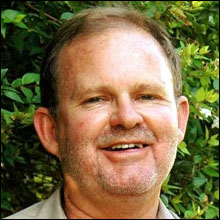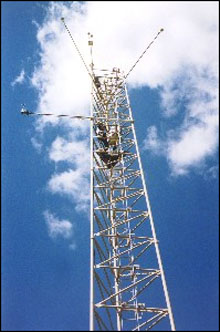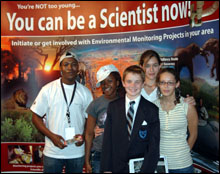2007 – Looking back on moving forward
|
By Johan Pauw, Head of SAEON
Looking back on 2007, it has been an exceptionally active year in all aspects of the SAEON mandate – observation, information management and education outreach.
Observation
Given the complexity of negotiations with node host organisations and the many participants of a node, the roll-out of a node could be a multi-year process.
In this regard, 2007 proved to be a successful year. We were able to accelerate the development of the SAEON Elwandle Node, fast-track the SAEON Egagasini Node by appointing a node manager, sign the hosting agreement for the SAEON Fynbos Node with SANBI and designate the first manager, as well as designate the two remaining nodes and advance to the final stages of signing their respective hosting agreements.
Work has even started in places where the nodes are still in conceptualisation phase. SAEON is negotiating with Drs Sue Milton and Richard Dean to systematically order their 20 years of wide-ranging Tierberg site data following the desired metadata standard EML, whereafter the data will be made available via SAEON. This work falls within the ambit of the envisaged Node for the Arid Lands.
In addition, SAEON has commissioned the CSIR for the upkeep of hydrological monitoring at Jonkershoek under mandate from the Department of Water Affairs and Tourism, since the observations were about to be disrupted by budgetary constraints. This work falls within the ambit of the SAEON Fynbos Node that will start up in January 2008.
The three operational nodes have started collating data from relevant sources, analysing the data and placing it on the CoGIS system. In some cases the digitisation of data has commenced and in the case of the SAEON Egagasini Node, a firm relationship has been established with the South African Data Centre for Oceanography (SADCO) that also maintains data for the African Ocean Biogeographic Information System (Afrobis).
The precious marine mammal strandings database of Bayworld in Port Elizabeth is being upgraded by the SAEON Elwandle Node through computerising the stranding data and making it more accessible to researchers. The node has also made a start with the compilation of a National Estuarine Database.
SAEON Ndlovu Node obtained and digitised approximately 50 years of rainfall data for the Hans Hoheisen Research Centre, as well as vegetation, game and rainfall data from three private nature reserves. They also began the collection of metadata for the environmental monitoring data held by the Palabora Mining Company.
The Node updated the database of river flow data (obtained from DWAF) and fish deaths for all rivers in the Kruger National Park. Data from all years (starting in the 1980s) is now combined in a single Access database.
The Node launched its first citizen science project, a long-term bird survey for the lowveld region (including the Kruger National Park). The project is something of an experiment for the Node, and will be used to gauge the value of “citizen science” projects as a means of environmental outreach, as well as for collecting useful data on environmental change.
SAEON Ndlovu Node also signed a collaborative agreement with the CSIR on atmospheric flux measurements in the Lowveld. In terms of the agreement SAEON provides access to certain facilities, salary support and technical assistance to the CSIR, and in return, the CSIR provides data and technical support to SAEON.
The project will use eddy covariance technology to measure fluxes of energy, H2O and CO2 between the land and atmosphere at up to four locations in the Lowveld. Two sites are located within the Kruger National Park, and two outside, in areas of rural land use.
The SAEON Elwandle Node has developed a series of eight baseline projects for Algoa Bay, ranging from studies on the dynamics of plankton communities and coastal land-use changes to estuarine ecology and sub tidal reef mapping. The node is currently advising the Council for Geosciences on priorities for the mapping of the near-shore seafloor.
In collaboration with SANParks and SAIAB, the node supports the data archiving and analysis for a 15-year inshore reef fish monitoring programme and a long-term monitoring programme looking at temporal change and spatial variation of offshore reef fish communities in a largely unmodified marine habitat at the Tsitsikamma National Park.
It is further establishing baseline marine data and a long-term monitoring programme for the management of the Greater Addo National Park.
The Node is also supporting a project of Prof Charles Griffiths of the University of Cape Town on long-term changes in rocky shore biota along the South African coast (1940 – 2007) with an assessment of drivers of change, which should lead to a PhD and delivery of the data to SAEON.
Already completed is a combined project between the Water Research Commission, Nelson Mandela Metropolitan University and SAEON to examine the effects of the August 2006 floods on the functioning of the Knysna and Swartvlei estuaries in the Southern Cape. The project is being continued to establish the present ecological state of the estuary through examining its current state versus the reference condition. The project will then review the implications of a number of flow reduction scenarios and establish their biological effects.
For its specialised inshore work the SAEON Elwandle Node has been equipped with a 8m rubber duck boat able to transport 12 people, as well as two current meters which will serve as “underwater weather stations”. The node will share this equipment with its partner organisations.
The Department of Science and Technology recently announced that Global Change will be addressed as one of its five Grand Challenges until 2008. Climate Change is seen as the most important component of Global Change and SAEON has been involved in the Department’s planning process around the Grand Challenge.
Indeed, SAEON has already commissioned the University of the Witwatersrand to downscale the available regional climate change models. A user workshop has been held and the final products are expected by the end of the year. SAEON’s infrastructure, data and information management system is foreseen to make a significant contribution to research on the topic of Global Change.
Similarly, SAEON will contribute to the realisation of a South African Earth Observation System of Systems (SAEOS) and the Global Earth Observation System of Systems (GEOSS). In addition, SAEON’s Egagasini and Elwandle nodes are partners in the ACCESS programme and its focus on ocean-atmospheric interactions and climate change.
SAEON has engaged with the national rangeland, grassland and biodiversity monitoring initiatives of the ARC and SANBI, and is in discussions with Prof Coert Geldenhuys of Forestwood on forest and woodland monitoring.
SAEON’s interest in longitudinal socio-economic demographic and health surveillance data has led to discussions with the AGINCOURT population health research programme with a view to multidisciplinary collaboration exploring human ecology and the impact of pandemics such as HIV-AIDS on natural resource use by rural communities.
With regard to its regional focus, SAEON continued its role as chair of ELTOSA and managed to produce the proceedings of the 2005 meeting in Malawi, and more importantly, to organise the fifth ELTOSA AGM and research planning workshop at the SAEON Ndlovu Node.
This very productive meeting was attended by Namibia, Botswana, Malawi, Mozambique and South Africa, and led to the conceptualisation of a broad-based joint long-term research programme focused on several river basins in the Savanna Biome. SAEON will assume a leading role in the further development of the programme.
Early in 2007, the University of Cape Town became one of a growing list of organisations to sign an Accession Agreement with SAEON. These agreements facilitate and order arrangements concerning the participation of affiliated persons in SAEON nodes, with specific reference to data management and sharing. SAEON is currently negotiating the same with the University of Pretoria.
The 2007 GEO Ministerial Summit in Cape Town at the end of November will provide an appropriate vehicle to publish a landmark South African Journal of Science volume that is dedicated to a multi-disciplinary series of papers resulting from the first SAEON Summit held in 2006. This publication is set to remain a benchmark in South African observation science for many decades to come.
As part of SAEON’s pursuit of excellence in observations science, a draft Core Science Plan for SAEON has seen the light. It points to several foundation projects that are required to inform and facilitate the core plan as it unfolds over time. The draft will be the topic of consultative stakeholder workshops during the course of 2008.
Information
The first phase in the development of the SAEON Data Portal has been completed and the basic technology for the operation has proven to be functional. Good progress was made with the development of a draft data policy. Data user and data provider agreements were developed based on legislation, user requirements and SAEON partner considerations.
The SAEON Data Portal provides entry to the shared capacity of the CoGIS system, a collaborative project to provide an electronic platform for data sharing and spatio-analytical capability. The co-sponsors of the project are the CSIR and the Department of Minerals and Energy.
Phase II of the project is aimed at developing the interoperability capacity for the CoGIS system to be linked to a variety of externally held data bases. Phase II started with establishing the User Requirement Specifications of potentially new participants such as Department of Environmental Affairs and Tourism (DEAT), SA National Biodiversity Institute (SANBI), Agricultural Research Council (ARC), SA National Parks (SANPARKS), Council for Geoscience, and the African Centre for Climate and Earth System Science (ACCESS). Phase II also plans to implement metadata management for more accurate searching and retrieval of data.
With a view to instil good data management discipline and standards, SAEON approached the National Research Foundation (NRF) grants section and proposed that future proposals to the NRF should include a section spelling out how data management will be performed as part of the research programme as well as how and when the data will be made available. Through this we hope to raise data management to its rightful level of importance in research.
SAEON supported the SANBI-initiated National Biodiversity Information Management workshop which was arranged to give effect to SANBI’s mandate to collect, collate, coordinate and disseminate biodiversity information. SANBI will also make use of the CoGIS system in future.
SAEON’s involvement and support for the South African Data Centre for Oceanography (SADCO) has increased through SAEON’s increased financial contribution to the consortium on behalf of the SAEON Egagasini Node. SADCO has signalled its intention to join in the CoGIS system partnership.
Education
The commissioning of an independent evaluation of the impact of the Education-Outreach programme of SAEON Ndlovu Node from 2004 to 2006, has been hailed as “brave” during the World Environmental Education Conference, where the report was presented.
Subsequently, it stimulated an NRF-wide debate, led by the South African Agency for Science and Technology Advancement (SAASTA), on best practice for evaluation processes.
An exciting result of the education-outreach programme, which has a primary focus on science and maths educators, is that 15 of those educators took it upon themselves to improve their skills. During the winter school holidays, they attended a SAQA-accredited environmental education course presented by the SA Wildlife College on location at the SAEON Ndlovu Node, but importantly, which they paid for themselves.
The SAEON Ndlovu Node’s Advenviro winter holiday camp was successfully repeated this year. This activity brings meritorious learners in direct contact with scientists. Some of these learners intend to take up science as a career.
As new nodes are being established, an education facilitator is appointed for each of them and by the end of this year an additional two would have joined SAEON.
The Graduate Student Network (GSN) is a brilliant initiative run by the students themselves. A highly successful gathering with prominent speakers, workshops and practical field trips was held in Cape Town this year, with financial support from SAEON. The conference was also attended by the three African MSc students who, with financial support from the National Ports Authority, started their studies this year at the SAEON Elwandle Node. A remarkable eleven students, of whom eight are from designated groups, are currently pursuing postgraduate work through SAEON Elwandle Node.
A second successful Eco-informatics learnership field trip was organised and facilitated as part of SAEON’s support for the DST’s Learnership programme. The programme teaches eco-informatics skills to unemployed graduates. SAEON collaborated with the CSIR, University of the Western Cape (UWC) and the ARC on the project.
SAEON was recently appointed by the Department of Science & Technology as the national coordinator for the Global Learning and Observation for the Benefit of the Environment (GLOBE) programme, an international schools programme supported by the USA government. The implementation of this programme in South Africa was agreed to by President Mbeki and Al Gore when the latter was the USA vice-president. SAEON and the Department are presently negotiating the terms of reference for the implementation of GLOBE.
Communication
The electronic newsletter continues to be well read by an international readership and will remain the primary method of communication with the broad stakeholder community. The newsletter does not only feature the activities of SAEON staff, but also regularly publicises the relevant activities of SAEON participants.
There were about twenty reports in the press about SAEON’s activities and this will be supported at a higher level by a chapter in the definitive publication, ‘The Full Picture’, which is to be released by GEO at its upcoming Summit.
A start has been made with the compilation of an illustrated book on environmental change, directed at informing decision-makers about dramatic and visible changes and advocating for sustained support of the SAEON observation system.






